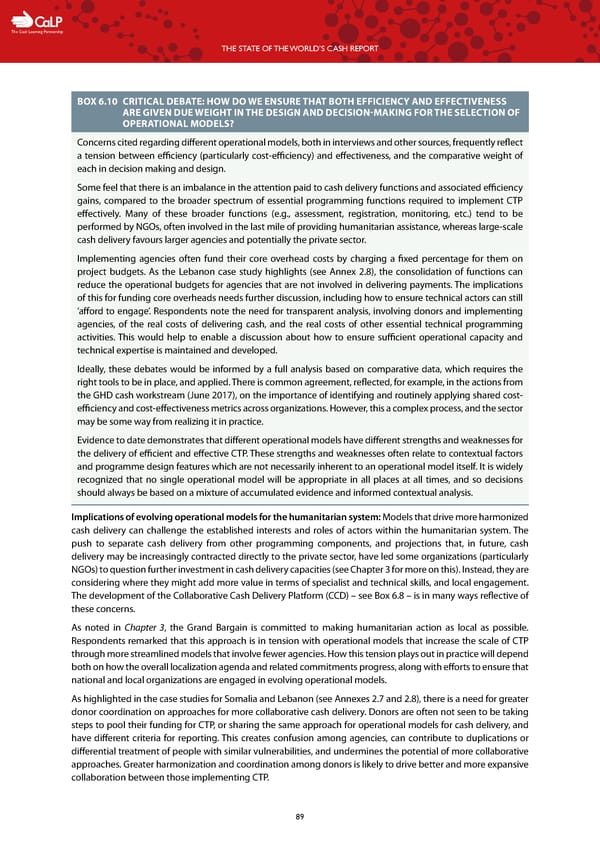C The Cash Learning Partnership THE STATE OF THE WORLD’S CASH REPORT BOX 6.10 CRITICAL DEBATE: HOW DO WE ENSURE THAT BOTH EFFICIENCY AND EFFECTIVENESS ARE GIVEN DUE WEIGHT IN THE DESIGN AND DECISION-MAKING FOR THE SELECTION OF OPERATIONAL MODELS? Concerns cited regarding different operational models, both in interviews and other sources, frequently reflect a tension between efficiency (particularly cost-efficiency) and effectiveness, and the comparative weight of each in decision making and design. Some feel that there is an imbalance in the attention paid to cash delivery functions and associated efficiency gains, compared to the broader spectrum of essential programming functions required to implement CTP effectively. Many of these broader functions (e.g., assessment, registration, monitoring, etc.) tend to be performed by NGOs, often involved in the last mile of providing humanitarian assistance, whereas large-scale cash delivery favours larger agencies and potentially the private sector. Implementing agencies often fund their core overhead costs by charging a fixed percentage for them on project budgets. As the Lebanon case study highlights (see Annex 2.8), the consolidation of functions can reduce the operational budgets for agencies that are not involved in delivering payments. The implications of this for funding core overheads needs further discussion, including how to ensure technical actors can still ‘afford to engage’. Respondents note the need for transparent analysis, involving donors and implementing agencies, of the real costs of delivering cash, and the real costs of other essential technical programming activities. This would help to enable a discussion about how to ensure sufficient operational capacity and technical expertise is maintained and developed. Ideally, these debates would be informed by a full analysis based on comparative data, which requires the right tools to be in place, and applied. There is common agreement, reflected, for example, in the actions from the GHD cash workstream (June 2017), on the importance of identifying and routinely applying shared cost- efficiency and cost-effectiveness metrics across organizations. However, this a complex process, and the sector may be some way from realizing it in practice. Evidence to date demonstrates that different operational models have different strengths and weaknesses for the delivery of efficient and effective CTP. These strengths and weaknesses often relate to contextual factors and programme design features which are not necessarily inherent to an operational model itself. It is widely recognized that no single operational model will be appropriate in all places at all times, and so decisions should always be based on a mixture of accumulated evidence and informed contextual analysis. Implications of evolving operational models for the humanitarian system: Models that drive more harmonized cash delivery can challenge the established interests and roles of actors within the humanitarian system. The push to separate cash delivery from other programming components, and projections that, in future, cash delivery may be increasingly contracted directly to the private sector, have led some organizations (particularly NGOs) to question further investment in cash delivery capacities (see Chapter 3 for more on this). Instead, they are considering where they might add more value in terms of specialist and technical skills, and local engagement. The development of the Collaborative Cash Delivery Platform (CCD) – see Box 6.8 – is in many ways reflective of these concerns. As noted in Chapter 3, the Grand Bargain is committed to making humanitarian action as local as possible. Respondents remarked that this approach is in tension with operational models that increase the scale of CTP through more streamlined models that involve fewer agencies. How this tension plays out in practice will depend both on how the overall localization agenda and related commitments progress, along with efforts to ensure that national and local organizations are engaged in evolving operational models. As highlighted in the case studies for Somalia and Lebanon (see Annexes 2.7 and 2.8), there is a need for greater donor coordination on approaches for more collaborative cash delivery. Donors are often not seen to be taking steps to pool their funding for CTP, or sharing the same approach for operational models for cash delivery, and have different criteria for reporting. This creates confusion among agencies, can contribute to duplications or differential treatment of people with similar vulnerabilities, and undermines the potential of more collaborative approaches. Greater harmonization and coordination among donors is likely to drive better and more expansive collaboration between those implementing CTP. 89
 The State of the World's Cash | Full Report Page 90 Page 92
The State of the World's Cash | Full Report Page 90 Page 92